

Research on Dual-band/Multi-band Photodetectors

Dual-band photodetectors have attracted enormous attention because of their potential in optical communication, biochemical detection, and environmental monitoring. However, the development of dual-band detectors is hindered by the lattice mismatch of mature bulk semiconductors with different energy gaps into the same photodetector pixel and the limited spectral region of emerging materials such as organic materials, two-dimensional materials, and perovskite materials. Colloidal quantum dots (CQDs) are promising materials for dual-band photodetectors because of their size-tunable bandgaps with wide spectral tunability and easy solution processability. Here, we proposed a dual-band visible and short-wave infrared (SWIR) detector based on metal chalcogenide CQDs (HgTe and CdTe CQDs). An n-type ZnO layer between CdTe and HgTe layers is introduced as the electron transport layer and hole barrier layer to prevent hole injection from different sensing layers, enabling detectors to switch between the visible and SWIR modes by changing the polarity and magnitude of the bias. The devices exhibit excellent performance with the detectivity above 1011 Jones. The visible/SWIR dual-band imaging is also demonstrated.
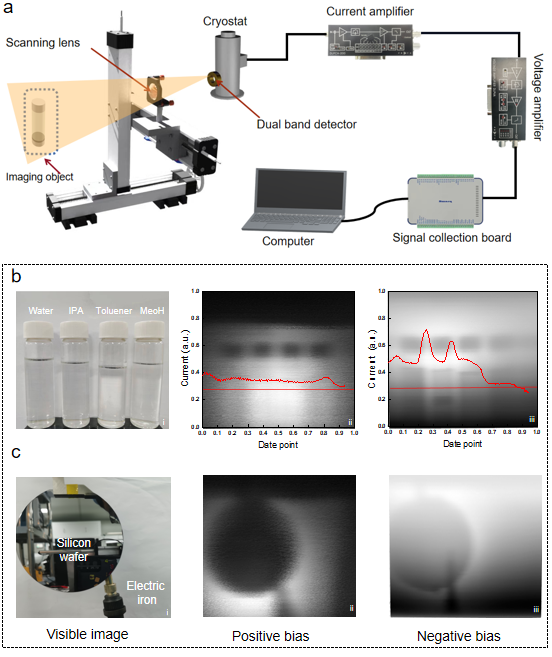
Zhang, S.; Bi, C.; Tan, Y.; Luo, Y.; Liu, Y.; Cao, J.; Chen, M.; Hao, Q.; Tang, X. ACS Nano 2022.
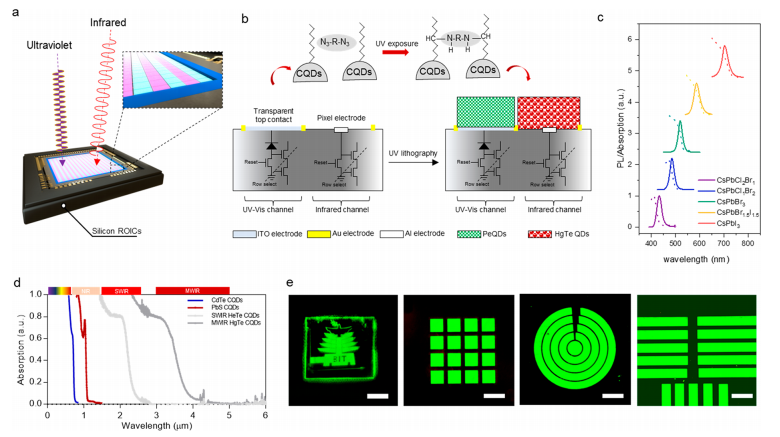
Complementary metal oxide semiconductor (CMOS) silicon sensors play a central role in optoelectronics with widespread applications from small cell phone cameras to large-format imagers for remote sensing. Despite numerous advantages, their sensing ranges are limited within the visible (0.4−0.7 μm) and near-infrared (0.8−1.1 μm) range , defined by their energy gaps (1.1 eV). However, below or above that spectral range, ultraviolet (UV) and short-wave infrared (SWIR) have been demonstrated in numerous applications such as fingerprint identification, night vision, and composition analysis. In this work, we demonstrate the implementation of multispectral broad band CMOS-compatible imagers with UV-enhanced visible pixels and SWIR pixels by layer-by-layer direct optical lithography of colloidal quantum dots (CQDs). High-resolution single-color images and merged multispectral images were obtained by using one imager. The photoresponse nonuniformity (PRNU) is below 5% with a 0% dead pixel rate and room-temperature responsivities of 0.25 A/W at 300 nm, 0.4 A/W at 750 nm, and 0.25A/W at 2.0 μm.
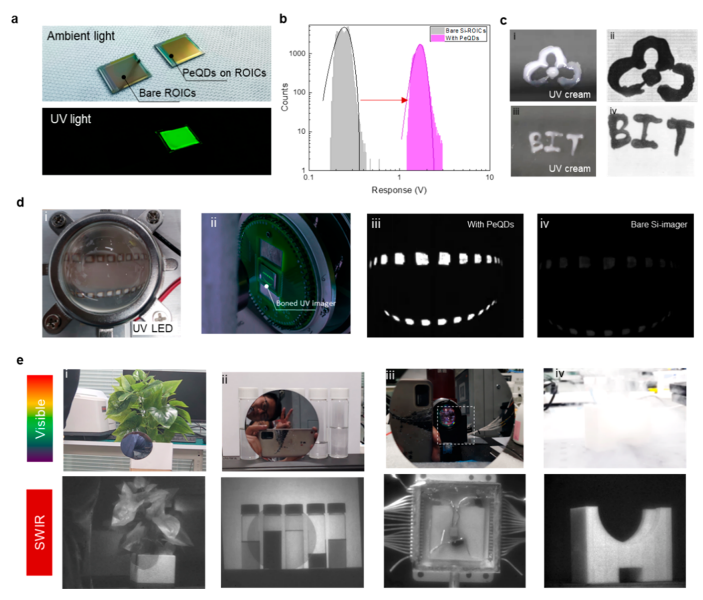
3. Single-/fused-band dual-mode mid-infrared imaging with colloidal quantum-dot triple-junctions
Shuo Zhang, Ge Mu, Jie Cao, Yuning Luo, Qun Hao, Menglu Chen, Yimei Tan, Pengfei Zhao, and Xin Tang, Photon. Res. 10, 1987-1995 (2022).

Image data acquired with fused multispectral information can be used for effective identification and navigation owing to additional information beyond human vision, including thermal distribution, night vision, and molecular composition. However, the construction of photodetectors with such capabilities is hindered by the structural complexity arising from the integration of multiple semiconductor junctions with distinct energy gaps and lattice constants. In this work, we develop a colloidal quantum-dot dual-mode detector capable of detecting, separating, and fusing photons from various wavelength ranges. Using three vertically stacked colloidal quantum-dot homojunctions with alternating polarity, single-band short-wave infrared imaging and fused-band imaging(short-wave and mid-wave infrared) can be achieved with the same detector by controlling bias polarity and magnitude. The dual-mode detectors show detectivity up to 8 × 1010 Jones at the fused-band mode and 3.1 × 1011 Jones at the single-band mode, respectively. Without image post-processing algorithms, the dual-mode detectors could provide both night vision and thermal information-enhanced night vision imaging capability. To the best of our knowledge, this is the first colloidal quantum-dot detector that can achieve such functionality. The operation mode can be changed at a high frequency up to 1.7 MHz, making it possible to achieve simultaneously dual-mode imaging and remote temperature sensing.
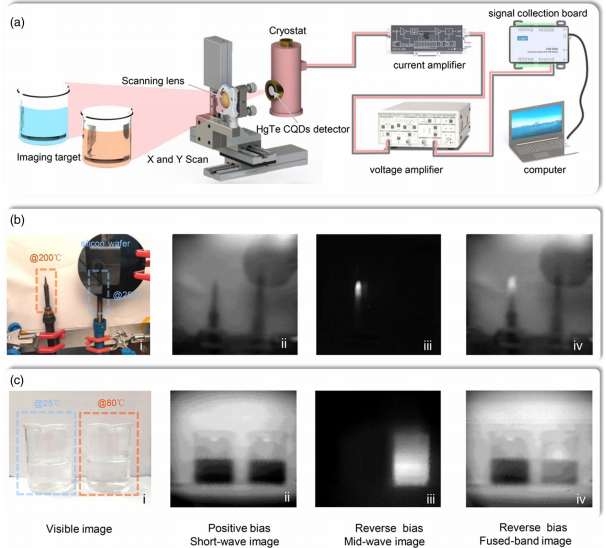
4. Resonant Cavity-Enhanced Colloidal Quantum-Dot Dual-Band Infrared Photodetectors
Luo, Y.; Zhang, S.; Tang, X.; Chen, M. J. Mater. Chem. C 2022, 10 (21), 8218–8225.

Infrared multispectral detection is explored extensively due to its wide applications in military reconnaissance, auto-driving and weather forecasting. As an alternative to epitaxial semiconductors, the wide spectral tunability and optical versatility of colloidal quantum dots (CQDs) have inspired various high-performance optoelectronic devices. Here, we demonstrate an integration of the CQD dual-band infrared photodetector and a Fabry–Perot resonance cavity, which provides a bias-switchable spectral response in the short-wave infrared (SWIR) and mid-wave infrared (MWIR) range. At the same time, the performance of the detector can be elevated by the improved optical collection efficiency and spectral selectivity due to the resonant cavity. The photodetector has a responsivity of 1.1 A W-1 and 1.6 A W-1 in SWIR and MWIR, respectively. The detector performance is illustrated by dual-band infrared imaging and spectral absorption measurement.
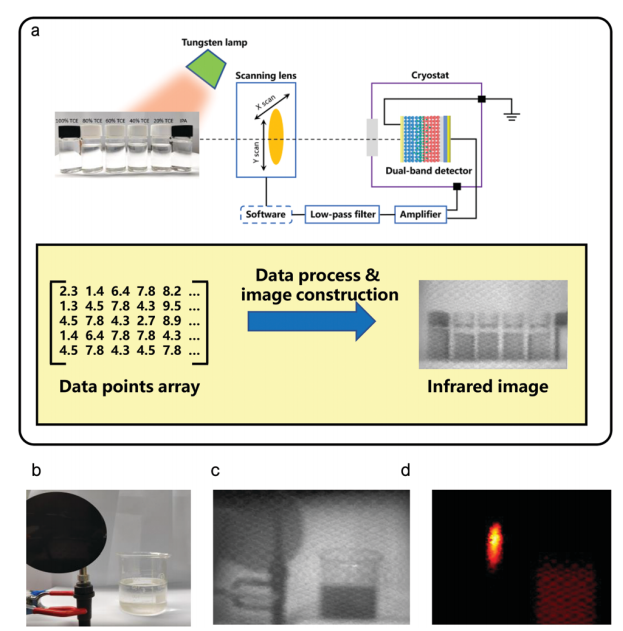
Tang, X.; Chen, M.; Kamath, A.; Ackerman, M. M.; Guyot-Sionnest, P., ACS Photonics 2020, 7, (5), 1117-1121.

Integration of infrared detectors with current silicon-based imagers would not only extend their spectral sensing range, but also enables numerous applications including thermal imaging, machine vision, and spectrometers. Here, we report the development of a dual-channel photodetector by depositing a colloidal quantum dot (CQDs) infrared photodiode onto a graphene/p-silicon Schottky junction to provide simultaneous visible and infrared photoresponse channels. The HgTe photodiode is patterned into a semitransparent mesh structure with varying fill factors so that the visible light reaches the silicon substrate. The graphene/silicon Schottky junction has a responsivity of ∼0.9 A/W in the visible and the infrared CQDs photodiode has a detectivity of ∼5 × 109 Jones at 2.4 μm for a filling factor of 0.1.

6. Dual-band infrared imaging using stacked colloidal quantum dot photodiodes
Tang, X.; Ackerman, M. M.; Chen, M.; Guyot-Sionnest, P., Nature Photonics 2019, 13, (4), 277-282.

Infrared multispectral imaging is attracting great interest with the increasing demand for sensitive, low-cost and scalable devices that can distinguish coincident spectral information. However, the widespread use of such detectors is still limited by the high cost of epitaxial semiconductors. In contrast, the solution processability and wide spectral tunability of colloidal quan-tum dots (CQDs) have inspired various inexpensive, high-performance optoelectronic devices. Here, we demonstrate a two-terminal CQD dual-band detector, which provides a bias-switchable spectral response in two distinct bands. A vertical stack of two rectifying junctions in a back-to-back diode configuration is created by engineering a strong and spatially stable doping process. By controlling the bias polarity and magnitude, the detector can be rapidly switched between short-wave infrared and mid-wave infrared at modulation frequencies up to 100 kHz with D* above 1010 Jones at cryogenic temperature. The detector performance is illustrated by dual-band infrared imaging and remote temperature monitoring.
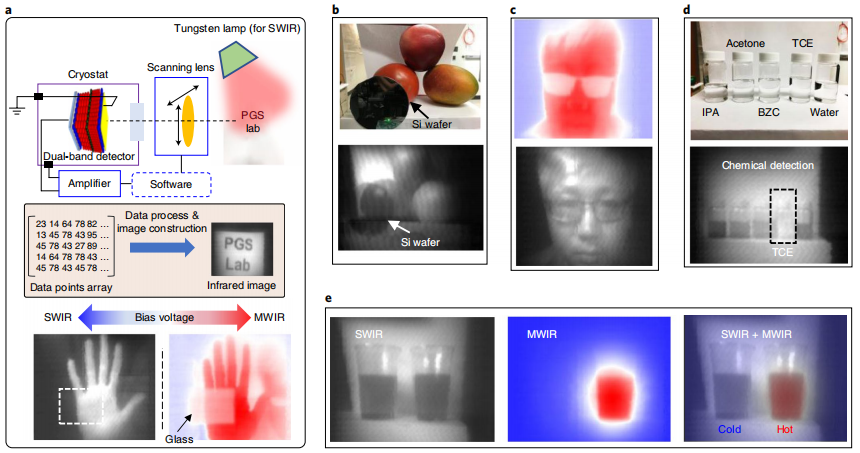

 E-mail: menglu@bit.edu.cn
E-mail: menglu@bit.edu.cn
 Address: No.5, South Street, Zhongguancun, Haidian District, Beijing(Click here)
Address: No.5, South Street, Zhongguancun, Haidian District, Beijing(Click here)